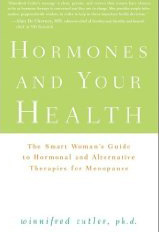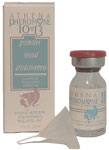
Chapter 5
Pelvic Problems: Bleeding and Pain, Hyperplasia, Cervical Cancer, and Endometriosis
"Look Inside" Dr. Winnifred Cutler's essential book; an excerpt from Chapter 5 for readers.
Click here for full book description
Copyright © 2009 John Wiley & Sons, Inc.
Hormones and Your Health: The Smart Woman's Guide to Hormonal and Alternative Therapies for Menopause
Excerpt pp 77-80
What does it mean when your uterus or pelvic organs send out distress signals, such as unexpected bleeding or pain with intercourse? It means you must take action to find the cause.
Unexpected Vaginal Bleeding
For every menstruating woman, bleeding is a fact of life; it’s healthy, functional bleeding—it has a purpose. Bleeding that is not expected is labeled dysfunctional. Dysfunctional uterine bleeding (DUB) is also called abnormal uterine bleeding, excessive menstrual bleeding, or menorrhagia (heavy menstrual bleeding). The good news is that abrupt changes in the length of the monthly cycle are often normal. Sudden changes in your sex life (ending a relationship or starting one after a time of celibacy) can cause hormonal and bleeding changes, but that has to do with the rhythm of your sex life, not with an underlying pathology.169
Aging can also bring changes: Hormonal secretion from your ovaries triggers a variety of normal changes in blood flow, timing, duration, and character, beginning around age 43 until menopause. All are part of the expected pattern of the change of life. And hormonal therapy regimens themselves generate their own patterns of “normal withdrawal bleeding.” But unexpected bleeding can also be a signal of disease and/or endocrine dysfunction. When you don’t know why you’re experiencing the bleeding, you need to consult your doctor.
As women approach menopause, their last 60 menstrual cycles normally contain a wide variety of cycle lengths.104 It is not unusual for the last cycles to range from 10 days to 20, 30, or even 60 days from the onset of one bleeding sequence to the onset of the next. Again, most unexpected bleeding is not caused by any pathology. A prescription for sequential HRT can often regularize this pattern.
How much blood loss is abnormal? You would have to lose at least 80 millileters (5.3 tablespoons) per cycle. Frankly, you won’t be measuring your flow, but you’ll know that it’s too much or too heavy if you have accidents in public, can’t leave the house, or otherwise lose control of your personal hygiene.657 Schedule a thorough medical evaluation and screening to rule out four potential causes. All of them need to be checked because more than one cause can coexist.
- Anatomical causes, such as fibroids, polyps, or endometrial hyperplasia
- Systemic (bodywide) causes, such as blood disorders or thyroid, liver, or renal disease
- Iatrogenic causes, the inadvertent result of your current medical treatment. Anticoagulants, tamoxifen, glucocorticoids, intrauterine devices (IUDs), certain herbal remedies. and steroid regimens can all trigger bleeding
- Hormonal causes, which are usually due to your not producing enough progesterone to stabilize the lining of the uterus
Fibroids occur in 80 percent of women and are a common cause of bleeding. They are discussed in Chapter 7.
Blood disorders can cause abnormal bleeding The most common is Von Willenbrand’s disease, which is found in 13 percent of women who experience heavy uterine bleeding.544 Symptoms that suggest this disease include easy bruising, frequent gum bleeds when flossing, one or two nose bleeds per month, and intervention-related bleeding at childbirth, tooth extraction, and/or surgery.416
If you have any of these symptoms along with abnormal vaginal bleeding, you need to locate a specialized center that has expert knowledge of blood disorders. It has been well documented that many analytical errors have been made by medical offices that do not specialize in blood disorders, so you will want to avoid the possibility of a misdiagnosis.have383, 416 Your gynecologist should be able to recommend a specialized center.
Insist on a thorough screening for any blood disorders. Recent evidence indicates that 10 to 15 percent of women who would have previously been misdiagnosed as having “ovulatory dysfunctional uterine bleeding” will actually reveal a systemic blood disorder if appropriate detailed testing is carried out.248 Other rarer blood abnormalities include:
- Platelet abnormalities
- Thrombocytopenias (abnormal decrease in platelet numbers)
- Thrombocytopathies (deficient function)
- Leukemias
- Coagulation factor deficiencies, such as vitamin K deficiency
- Congenital disorders
- Using anticoagulants248
Other systemic problems that are associated with heavy bleeding include:
- Blood tests for the thyroid hormone screening (TSH screening) may reveal abnormal thyroid hormone levels. A reproductive endocrinologist can help you.
- Anovulation (absence of ovulation) is identified when blood tests reveal an absence of progesterone in the 4 to 10 days before menses. An appropriately timed prescription for progesterone helps normalize such bleeding if you are still premenopausal.
- Vitamin A deficiencycan cause heavy menstrual bleeding. Vitamin A supplements of 25,000 IU twice daily resolved problems within 2 weeks in 37 of 40 bleeders after blood tests revealed deficiencies.457 Supplementation of this magnitude should not be done without a physician’s guidance.
**This Chapter is complex and very important. These topics are also covered in this chapter:
- Medical Evaluation of the Uterus
- Your First Meeting with Your Gynecologist: What to Expect
- Hormones and Hyperplasia
- Endometriosis: Pain in the Pelvis
- What causes Endometriosis?
- Avoid a Hysterectomy
END OF EXCERPT
Dr. Cutler's pheromone science has been "bottled" into vials of unscented fragrance additives that increase wearers' sexual attractiveness. AVAILABLE FOR PURCHASE HERE

